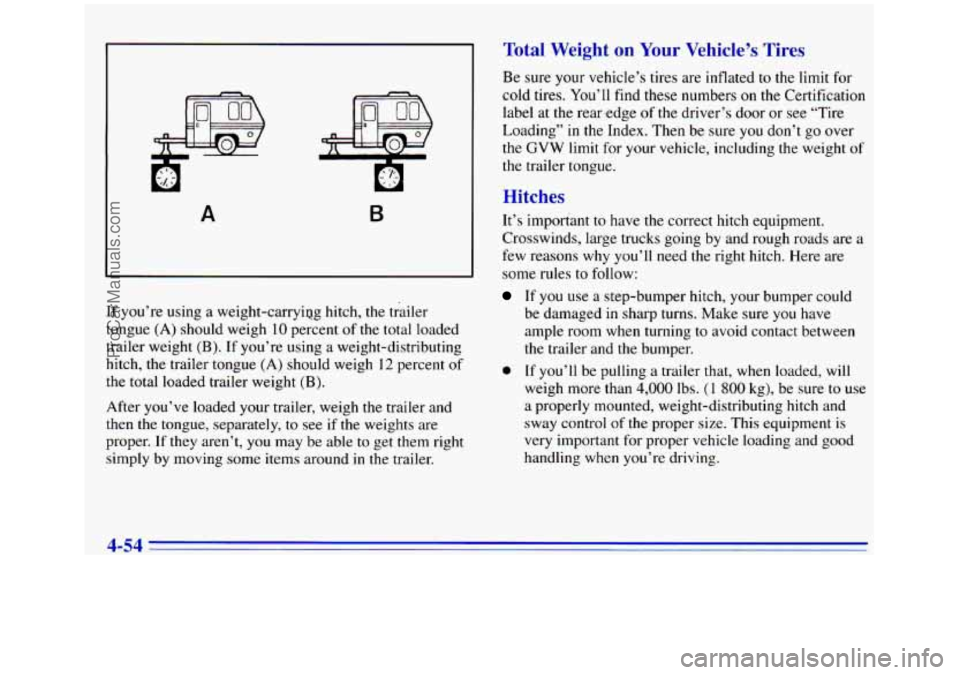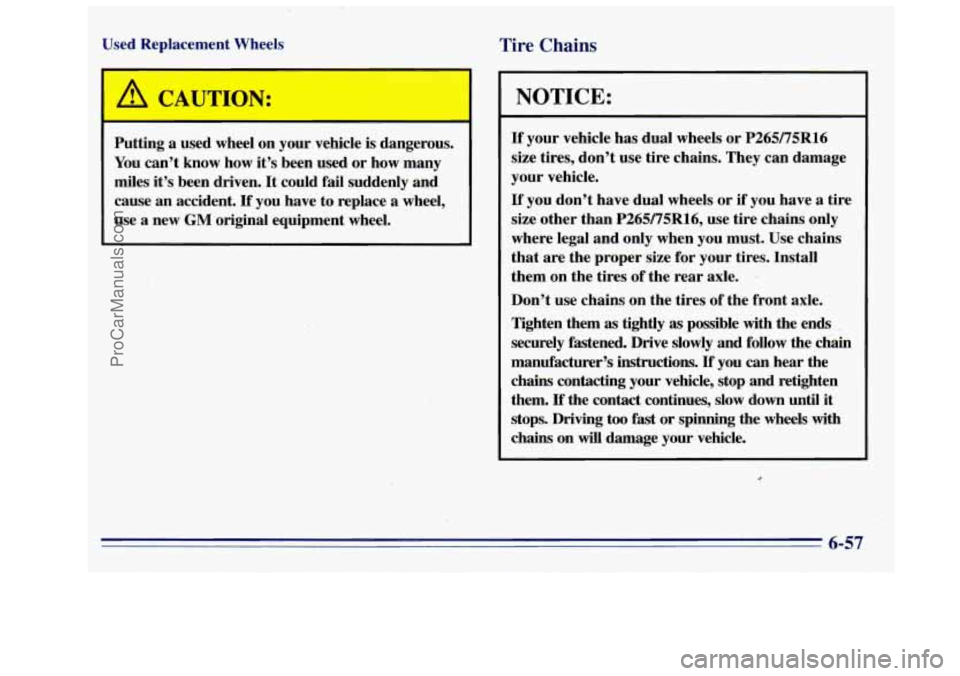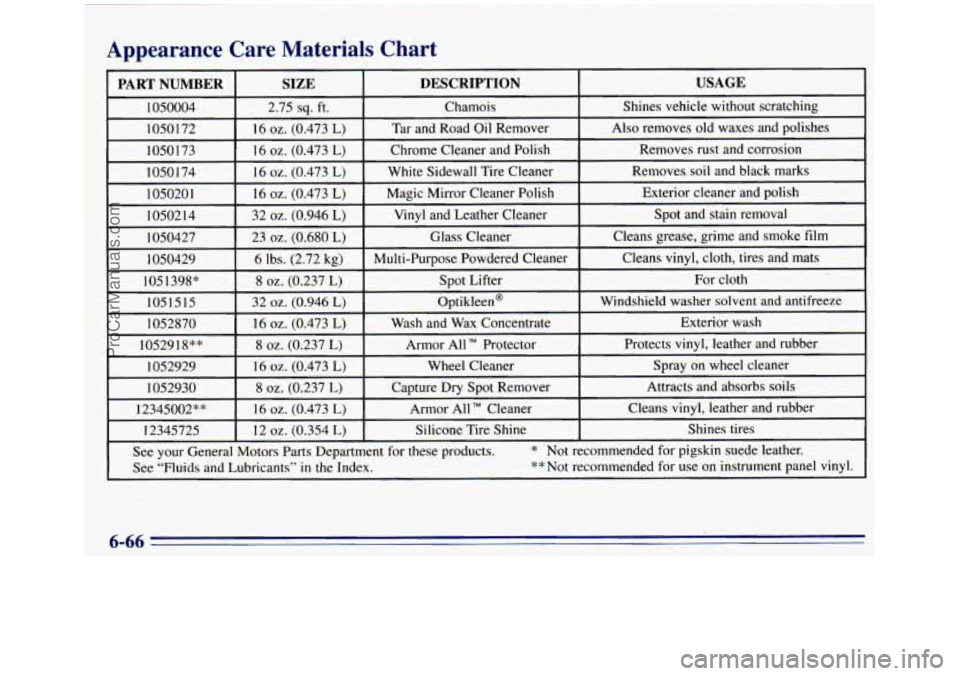1996 GMC SIERRA tire size
[x] Cancel search: tire sizePage 196 of 404

Loading Your Vehicle
n ", ,. , I --- SEE OWNER'S MANUAL FOR ADDITIONAL INFORMATION I U
The Certificatiomire label is found on the rear edge of
the driver's door or in the Incomplete Vehicle Document
in the cab.
The label shows the size of your original tires and the
inflation pressures needed to obtain the gross weight
capacity
of your vehicle. This is called the GVWR
(Gross Vehicle Weight Rating).
The GVWR includes the
weight of the vehicle, all occupants, fuel and cargo.
The Certificationmire label also tells
you the maximum
weights for the front and rear axles, called Gross
Axle
Weight Rating (GAWR). To find out the actual loads on your
front and rear axles,
you need to go to a weigh
station and weigh your vehicle. Your dealer can help
you with this. Be sure to spread out your load equally on
both sides of the centerline.
Never exceed the GVWR for your vehicle, or the
GAWR for either the front or rear axle.
And,
if you do have a heavy load, you should spread
it
out.
I
In the case of a sudden stop or collision, things
carried in the bed
of your truck could shift
forward and come into the passenger area,
injuring you and others.
If you put things in the
bed
of your truck, you should make sure they are
properly secured.
Using heavier suspension components to get added
durability might not change your weight ratings. Ask
your dealer to help you load your vehicle the right way.
4-42
ProCarManuals.com
Page 208 of 404

A B
If you’re using a weight-carryipg hitch, the trailer
tongue
(A) should weigh 10 percent of the total loaded
trailer weight
(B). If you’re using a weight-distributing
hitch, the trailer tongue
(A) should weigh 12 percent of
the total loaded trailer weight
(B).
After you’ve loaded your trailer, weigh the trailer and
then the tongue, separately,
to see if the weights are
proper.
If they aren’t, you may be able to get them right
simply
by moving some items around in the trailer.
Total Weight on Your Vehicle’s Tires
Be sure your vehicle’s tires are inflated to the limit for
cold tires.
You’ll find these numbers on the Certification
label at the rear edge
of the driver’s door or see “Tire
Loading” in the Index. Then be sure
you don’t go over
the
GVW limit for your vehicle, including the weight of
the trailer tongue.
Hitches
It’s important to have the correct hitch equipment.
Crosswinds, large trucks going by and rough roads are a
few reasons why you’ll need the right hitch. Here are
some rules
to follow:
If you use a step-bumper hitch, your bumper could
be damaged
in sharp turns. Make sure you have
ample room when turning
to avoid contact between
the trailer and the bumper.
0 If you’ll be pulling a trailer that, when loaded, will
weigh more than
4,000 Ibs. (1 800 kg), be sure to use
a properly mounted, weight-distributing hitch and
sway control
of the proper size. This equipment is
very important for proper vehicle loading and good
handling when you’re driving.
ProCarManuals.com
Page 302 of 404

When It’s Time for New Tires
Rust or dirt on
a wheel, or on the parts to which
it
is fastened, can make- wheel nuts become loose
.after
a time. The wheel could come off and cause
an accident. When you change
a wheel, remove
any rust or dirt from places where the wheel
attaches to the vehicle. In an emergency, you can
use a cloth or a paper towel to do this; but be
sure to use
a scraper or wire brush later, if you
need to, to get all the rust or dirt
off. (See
“Changing a Flat Tire” in the Index.) One
way to tell when it’s
time for new tires is
to
check the treadwear
indicators, which will
appear when your tires have
only
1/16 inch (1.6 mm) or
less
of tread remaining.
Some commercial truck
tires may not have
treadwear indicators.
Its
You need a new tire if any of the following statemen
are true:
0 You’can see the indicators at three or more places
around the tire.
You can see cord or fabric showing through the tire’s
rubber.
0 The tread or sidewall is cracked, cut or snagged deep
enough to show cord or fabric.
0 The tire has a bump, bulge or split.
0 The tire has a puncture, cut or other damage that ,
can’t be repaired well because of the size or location
of the damage.
ProCarManuals.com
Page 303 of 404

Dual Tire Operation
When the vehicle is new, or whenever a wheel, wheel
bolt or wheel nut is replaced, check the wheel nut torque
after
100, 1,000 and 6,000 miles ( 160, I 600 and IO 000
km) of driving. For proper torque, see "Wheel Nut
Torque" in the Index.
The outer tire on a dual wheel setup generally wears
faster than the inner tire. Your tires will wear more
evenly and last longer
if you rotate the tires periodically.
If you're going to be doing a lot of driving on
high-crown roads,
you can reduce tire wear by adding
5 psi (35 kPa) to the tire pressure in the outer tires. Be
sure to return to the recommended pressures when no
longer driving under those conditions. See "Changing
a
Flat Tire" in the Index for more information.
A CAUTION:
I
If you operate your vehicle with a tire that is
badly underinflated, the tire can overheat. An
overheated tire can lose air suddenly or catch fire.
You or others could be injured. Be sure
all tires
(including the spare, if any) are properly inflated.
Buying New Tires
To find out what kind and size of tires you need, look at
the Certificntion/Tire label.
Tlze tires installed
on your vehicle when it was new had
a Tire Performance Criteria Specification (TPC Spec)
number
on each tire's sidewall. When you get new tires,
get ones
with that same TPC Spec number. That way
your vehicle
will continue to have tires that are designed
to give proper endurance, handling, speed rating,
traction, ride and other things during normal service
on
your vehicle. If your tires have an all-season tread
design,
the TPC number will be followed by an "MS"
(for mud and snow).
If you ever replace your tires with those not having a
TPC
Spec number, make sure they are the same size,
load range, speed rating and construction type
(bias,
bias-belted or radial) as your original tires.
6-53
ProCarManuals.com
Page 304 of 404

-
A CAUTION:
Mixing tires could cause you to lose control while
driving.
If you mix tires of different sizes or types
(radial and bias-belted tires), the vehicle may not
handle properly, and you could have a crash.
Using tires of different sizes may also cause
damage to your vehicle.
Be sure to use the same
size and type tires on all wheels.
Uniform Tire Quality Grading
The following information relates to the system
developed by the United States National Highway
Traffic Safety Administration, which grades tires
by
treadwear, traction and temperature performance.
(This applies only to vehicles sold in the United States.)
The grades are molded on the sidewalls of most
passenger car tires. The Uniform Tire Quality Grading
system does
not apply to deep tread, winter-type snow
tires, space-saver or temporary
use spare tires, tires with
nominal rim diameters
of IO to 12 inches (25 to 30 cm),
or to some limited-production tires. While
the tires available on General Motors passenger
cars and light trucks may vary with respect to these
grades,
they must also conform to Federal safety
requirements and additional General Motors Tire
Performance Criteria (TPC) standards.
Treadwear
The treadwear grade is a comparative rating based on
the wear rate of the tire when tested under controlled
conditions on
a specified government test course. For
example. a tire graded 150 would wear one and a half
(1 1/2) times as well on the government course as a tire
upon the actual conditions of their use, however, and
may depart significantly from
the norm due to variations
in driving habits, service practices and differences in
road characteristics and climate.
E at-aded 100. The relative performance of tires depends
Traction -- A, B, C
The traction grades, from highest to lowest, are A, B, and
C, and they represent
the tire’s ability to stop on wet
pavement as measured under controlled conditions on
specified government test surfaces
of asphalt and concrete.
A tire marked C may have poor traction performance.
Warning: The traction grade assigned
to this, tire is based
on braking (straightahead) traction tests and does not
include cornering (turning) traction.
6-54
ProCarManuals.com
Page 307 of 404

Used Replacement Wheels Tire Chains
1
-- 4
Putting a used wheel .on your vehicle is dangerous.
You can’t know how it’s been used or how many
miles it’s been driven.
It could fail suddenly and
cause an accident.
If you have to replace a wheel,
use a new
GM original equipment wheel.
NOTICE:
If your vehicle has dual wheels or P265/75R16
size tires, don’t use tire chains. They can damage
your vehicle.
If you don’t have dual wheels or if you have a tire
size other than P265/75R16, use tire chains only
where legal and only when you must. Use chains
that are the proper size for your tires. Install
them on the tires of the rear axle.
Don’t use chains on the tires of the front axle.
Tighten them as tightly as possible with the ends
,
securely fastened. Drive slowly and follow the chain
manufacturer’s instructions.
If you can. hear the
chains ‘contacting your vehicle, stop and retighten
them.
If the contact continues, slow dawn until it
stops. Driving too fast or spinning the wheels with
chains on
will damage your vehicle.
4
6-57
ProCarManuals.com
Page 316 of 404

Appearance Care Materials Chart
PART NUMBER ’ SIZE DESCRIPTION USAGE
1050004 2.75 sq. ft. Chamois Shines vehicle without scratching
1050 172
16 oz. (0.473 L) Tar and Road Oil Remover Also removes old waxes and polishes
10501 73 16
oz. (0.473 L) Chrome Cleaner and Polish Removes rust and corrosion I I
I 1050174 I 16 oz. (0.473 L) I White Sidewall Tire Cleaner I Removes. soil and black marks I
See “Fluids and Lubricants” in the Index.
6-66 m
ProCarManuals.com